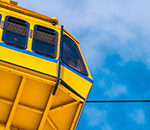A teleconverter is a small secondary lens unit that is placed between the camera body and the lens. It is useful to increase your reach as it increases the apparent focal length of your lens. This is great for those who cannot afford long lenses, or those who shoot primarily wildlife. However, there are a few things you should be aware of before purchasing a teleconverter. In today’s video, photographer Jared Polin sheds some light on the matter:
“Where most people go wrong with teleconverters is they don’t realize the cause and effect it has on their settings.”
Brands market teleconverters by promising they will help increase your lens’s reach. But what they won’t tell you is that there are a lot of downfalls to this. A lens is a great piece of engineering designed with the intention of projecting the clearest image on the sensor. Introducing any optical element, either in front of the lens or in between the lens and the sensor, can only hamper the quality.
Like Polin demonstrates in the video, the first thing you will immediately notice is a loss of light. For instance, a 2x teleconverter means a 2-stop loss of light. And this is just the beginning. To compensate for the loss, you will need to increase your ISO, which will invariably introduce noise. So if you’re thinking of getting a teleconverter for some fast-action sports or wildlife photography, you seriously need to consider all of these variables.
Moreover, the setup’s performance will also take a hit as the loss of light causes the lens to focus slower. As Polin clearly shows in the video, there is a clear loss of sharpness. If image clarity is critical, you’d be better off avoiding a teleconverter and cropping the image instead.
“Don’t waste your money on a teleconverter thinking it will give you great results—because it won’t.”
For an in-depth analysis of how teleconverters can affect your photography, be sure to watch the complete video. And if you use teleconverters for your photography, we’d love to hear your experience as well.
Like This Article?
Don't Miss The Next One!
Join over 100,000 photographers of all experience levels who receive our free photography tips and articles to stay current:





Ok, so, first off, I am NOT, by any stretch of the imagination, a camera guru. Heck, I’ve been a point/shoot guy for years & am only NOW moving into my first Bridge Camera on my way, hopefully, to a real DSLR one day. I’ watched your vid and have a question. I get what you said about the loss of light & f-stop alteration when using a teleconverter. However, what if I had a fixed aperture lens that is wide? Would it really matter? For example, take the FZ300/330 with a fixed f2.8 25mm-600mm zoom. Let’s say I slap on a 1.7 x VCL DX 1758 or a TCON-17. So, I lose light and move up to f4.5 @ 1200mm. I’m not sure this matters much since that seems to actually be BETTER than what is standard on many variable zoom camera. For example, the Canon PowerShot SX70 21mm – 1365mm f.3.4 – 6.5. Or, the FZ2500, which actually goes only from 24mm – 480mm with a variable aperture of f 2.8 – 4.5. So, why not use that fixed aperture of 2.8 on the FZ300/330 w/ a 1.7x and I’m still only at 4.5, which seems acceptable…. I think. Thanks in advance for answering. (Thinking of getting your fropacks. They look cool)